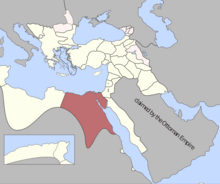
Back إيالة مصر Arabic ايالة مصر ARZ Exiptu Otomanu AST Misir əyaləti Azerbaijani Египетски еялет Bulgarian Egipat za vrijeme osmanlijske vladavine BS Província otomana d'Egipte Catalan Egyptský ejálet Czech Osmanenherrschaft in Ägypten German Εγιαλέτι της Αιγύπτου Greek
| Ottoman Egypt إيالة مصر (Arabic) Iyalat Misr ایالت مصر (Ottoman Turkish) Eyālet-i Mıṣr | |||||||||||||||||||
|---|---|---|---|---|---|---|---|---|---|---|---|---|---|---|---|---|---|---|---|
| Ottoman Province (1517–1805) Autonomous Province (1805–1914) | |||||||||||||||||||
| 1517–1914 | |||||||||||||||||||
 Map of the Eyalet of Egypt in 1795 | |||||||||||||||||||
 Expansion of the Eyalet under Muhammad Ali and his sons | |||||||||||||||||||
| Capital | Cairo | ||||||||||||||||||
| Demonym | Egyptians | ||||||||||||||||||
| Population | |||||||||||||||||||
• 1700 | 2,335,000 | ||||||||||||||||||
• 1867 | 6,076,000 | ||||||||||||||||||
| Government | |||||||||||||||||||
| Grand Vizier | |||||||||||||||||||
• 1857–1858 | Zulfiqar Pasha (first) | ||||||||||||||||||
• 1866–1867 | Sherif Pasha (last) | ||||||||||||||||||
| Historical era | Early modern period | ||||||||||||||||||
| 1517 | |||||||||||||||||||
| 1798–1801 | |||||||||||||||||||
| 1801–1805 | |||||||||||||||||||
| 1820–1822 | |||||||||||||||||||
| 1831–1833 | |||||||||||||||||||
| 1867 | |||||||||||||||||||
| 1882 | |||||||||||||||||||
| 1914 | |||||||||||||||||||
| |||||||||||||||||||
Ottoman Egypt was an administrative division of the Ottoman Empire after the conquest of Mamluk Egypt by the Ottomans in 1517.[1] The Ottomans administered Egypt as a province (eyalet) of their empire (Ottoman Turkish: ایالت مصر, romanized: Eyālet-i Mıṣr).[2][better source needed] It remained formally an Ottoman province until 1914, though in practice it became increasingly autonomous during the 19th century and was under de facto British control from 1882.[3]
Egypt always proved a difficult province for the Ottoman Sultans to control, due in part to the continuing power and influence of the Mamluks, the Egyptian military caste who had ruled the country for centuries. As such, Egypt remained semi-autonomous under the Mamluks until Napoleon Bonaparte's French forces invaded in 1798. After Anglo-Turkish forces expelled the French in 1801, Muhammad Ali Pasha, an Albanian military commander of the Ottoman army in Egypt, seized power in 1805, and established a quasi-independent state.
Egypt under the Muhammad Ali dynasty remained nominally an Ottoman province. In reality, it was practically independent and went to war twice with the empire—in 1831–33 and 1839–41. The Ottoman sultan granted Egypt the status of an autonomous vassal state or Khedivate in 1867.[citation needed] Isma'il Pasha (Khedive from 1867 to 1879) and Tewfik Pasha (Khedive from 1879 to 1892) governed Egypt as a quasi-independent state under Ottoman suzerainty until the British occupation of 1882. Nevertheless, the Khedivate of Egypt (1867–1914) remained a de jure Ottoman province until 5 November 1914,[4] when the Sultanate of Egypt was declared a British protectorate in reaction to the Young Turks of the Ottoman Empire joining the First World War on the side of the Central Powers (October–November 1914).
- ^ Faroqhi, Saraiya (2008). The Ottoman Empire: A Short History. Shelley Frisch, translator. Princeton, New Jersey: Markus Wiener Publishers. p. 60. ISBN 978-1-55876-449-1. OCLC 180880761.
- ^ "Some Provinces of the Ottoman Empire". Geonames.de. Archived from the original on 10 July 2015. Retrieved 25 February 2013.
- ^ Daly, M. W., ed. (1998). The Cambridge History of Egypt, Volume 2: Modern Egypt, from 1517 to the end of the twentieth century. Cambridge University Press. pp. 139–246. ISBN 978-0-521-47211-1.
- ^ Full text of the Treaty of Lausanne (1923): Article 17 of the treaty refers to Egypt and Sudan.
© MMXXIII Rich X Search. We shall prevail. All rights reserved. Rich X Search

